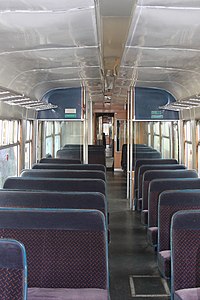
The British Rail Class 121 is a single-car double-ended diesel multiple unit. 16 driving motor vehicles were built from 1960, numbered 55020–55035. These were supplemented by ten single-ended trailer vehicles, numbered 56280–56289. They have a top speed of 70 mph, with slam-doors, and vacuum brakes. The driving motor vehicles were nicknamed "Bubble Cars" by some enthusiasts.
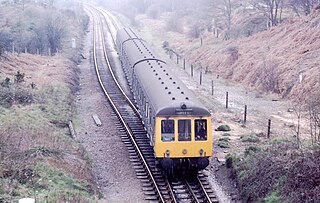
The British Rail Class 116 diesel multiple units were built by BR Derby from 1957 to 1961. Introduced as part of the British Railways Modernisation Plan in the mid 1950s, as with other first generation DMUs the 116 was intended to replace steam trains and reduce costs across the rail network. Alongside Metro-Cammell, BR Derby had prior experience with DMUs, having developed a Lightweight Unit, and so was awarded a contract for a new design.

The British Rail Class 114 diesel multiple units were built by BR Derby from September 1956 to July 1957. Forty-nine 2-car units were built, numbered E50001-49 for driving motors and E56001-49 for driving trailers. The units were used in the early days out of 40A Lincoln TMD (LN) on services all over the county, although a small number were transferred to 41A Sheffield (Darnall) during 1959/60.

British Rail produced a variety of railbuses, both as a means of acquiring new rolling stock cheaply, and to provide economical services on lightly-used lines.

The British Rail Class 104 diesel multiple units were built by Birmingham Railway Carriage and Wagon Company from 1957 to 1959.

The British Rail Classes 101 and 102 diesel-mechanical multiple units were built by Metro-Cammell at Washwood Heath in Birmingham, England from 1956 to 1959, following construction of a series of prototype units. These classes proved to be some of the most successful and longest-lived of BR's First Generation DMUs, second in longevity only to the Class 121, with the final five units being withdrawn on 24 December 2003. The oldest set was, by then, just over 47 years old.

The British Rail Class 127 diesel multiple units were built by BR Derby in 1959. Thirty 4-car units were built, formed of two outer driving motor vehicles, sandwiching two intermediate trailers which were classified class 186. The technical description of such as 4-car unit was DMBS + TSL + TS + DMBS.

The British Rail Class 118 diesel multiple units were built by the Birmingham Railway Carriage and Wagon Company (BRCW) and introduced from 1960. It was a licence-built version of the British Rail Class 116.
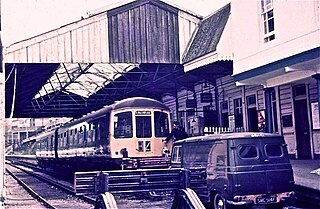
The British Rail Class 103 diesel multiple units were built by Park Royal Vehicles with diesel engines by British United Traction (BUT). Ordered in the first half of 1955, 20 of these sets were built by Park Royal at the Crossley Motors works in Stockport of the ACV Group. They consisted of a power car and a driving trailer. Standard BUT equipment was fitted, with 'A' type engines.
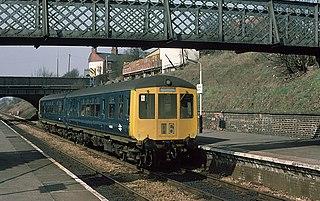
The British Rail Class 100 diesel multiple units were built by Gloucester Railway Carriage and Wagon Company Limited from 1956 to 1958, designed and built in collaboration with the Transport Sales Dept. of T.I. Ltd.

The British Rail Class 117 diesel multiple units (DMUs) were built by Pressed Steel from 1959 to 1961. It was a licence-built variant of the British Rail Class 116.
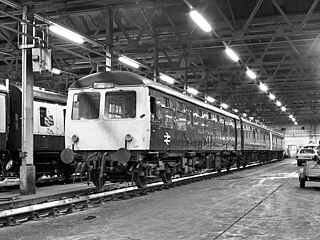
The British Rail Classes 105 and 106 diesel multiple units were built by Cravens Ltd. of Sheffield from 1956 to 1959. The class were built with a side profile identical to British Railways Mark 1 carriage stock, using the same doors and windows. None were selected for refurbishment. The last passenger car was withdrawn from service in 1988.

The British Rail Class 107 diesel multiple units were built by the Derby Works of British Railways and were introduced in 1960. The class looked similar to the later Class 108 units, but were heavier - having been built out of steel.

The Class 110 diesel multiple units were built by the Birmingham Railway Carriage and Wagon Company in conjunction with the Drewry Car Co. to operate services on the former Lancashire and Yorkshire main line. They originally entered service uniquely in this region, which earned them the name of the 'Calder Valley' sets. They were an updated version of the Class 104, with more powerful engines, a revised cab design and raised bodyside window frames.

The Class 111 DMUs were based on Class 101/2s, but with different engines. The only external body difference was on the final batch of cars where a four character headcode box was fitted above the front cab windows, with the destination indicator on top of a reduced height centre window.
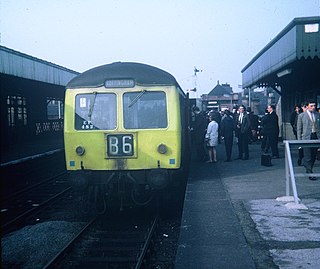
The Class 112 and Class 113 DMUs used the standard Cravens body used on Class 105s but had a single Rolls-Royce C8NFLH engine rated at 238 hp (177 kW) per car, all of which formed into 'power twins' – two car sets with both vehicles powered.

The British Rail Class 115 diesel multiple units were 41 high-density sets which operated the outer-suburban services from Marylebone usually to destinations such as High Wycombe, Aylesbury and Banbury which are on the Chiltern Main Line and Great Central Main Line. Sometimes, these sets used to operate 8- or 12-car-long expresses to Nottingham Victoria in the final years of the GCML. Coincidentally, Class 115 units operated services under Table 115 in the British Rail timetable.

The British RailClass 141 was the first production model of the Pacer diesel multiple unit (DMU) railbus.

The British Rail Class 125 was a design of three car Diesel Multiple Unit built by BR Derby at Derby Works in 1958. They were almost identical in appearance to the Class 116.

Diesel multiple units and railcars are trains, usually with passenger accommodation, that do not require a locomotive. Railcars can be single cars, while in multiple units cars are marshalled together with a driving position either end. As of December 2010, 23 percent of the rail passenger cars used on Network Rail are part of a diesel multiple unit.

